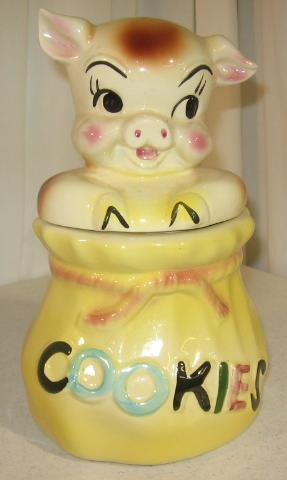Cookie jar
Cookie Jar refers to a container used to store cookies or biscuits. Traditionally made from ceramic or glass, cookie jars are a staple in many kitchens around the world. They can vary greatly in design, ranging from simple and functional to ornate and decorative. Cookie jars not only serve a practical purpose by keeping cookies fresh, but they have also become collectible items, with some vintage or unique jars fetching high prices among collectors.
History[edit | edit source]
The concept of storing food in containers dates back thousands of years, but the specific tradition of keeping cookies in jars is believed to have become popular in the United States in the early 20th century. The rise of cookie jar popularity coincided with the mass production of cookies and the increasing availability of pre-packaged baked goods. Manufacturers began producing cookie jars in a variety of shapes, sizes, and designs, often featuring popular cartoon characters, animals, or other whimsical themes to appeal to children and adults alike.
Materials and Design[edit | edit source]
Early cookie jars were typically made of glass or ceramic, materials that remain popular due to their non-porous nature, which helps to keep cookies fresh. Metal and plastic jars are also available, but they are less common due to concerns over durability and food safety.
Designs can range from simple and utilitarian to highly artistic or whimsical. Some jars are designed to look like the cookies they are meant to hold, while others may take the form of popular cultural icons or seasonal themes. The diversity in design makes cookie jars appealing to collectors, who may focus on jars from specific eras, manufacturers, or themes.
Collectibility[edit | edit source]
The collectibility of cookie jars has grown significantly over the years. Collectors often seek out rare or unique jars, with some of the most sought-after pieces coming from limited production runs or being made by well-known manufacturers. The condition of the jar, rarity, and historical significance can all affect its value. Auctions and online marketplaces have made it easier for collectors to find and acquire specific jars, further fueling the hobby's popularity.
Care and Maintenance[edit | edit source]
To ensure the longevity of a cookie jar and to keep its contents fresh, proper care and maintenance are essential. Ceramic and glass jars should be washed by hand with mild soap and water, as dishwashers can damage their finishes or cause them to crack. Metal and plastic jars should be checked for manufacturer's instructions on care. Regardless of material, the lid's seal should be checked regularly to ensure it remains airtight.
Conclusion[edit | edit source]
Cookie jars are more than just containers for sweets; they are a reflection of cultural trends, artistic design, and personal taste. Whether used for their intended purpose of storing cookies or as collectible items, cookie jars hold a special place in the hearts of many, embodying both nostalgia and practicality.
Navigation: Wellness - Encyclopedia - Health topics - Disease Index - Drugs - World Directory - Gray's Anatomy - Keto diet - Recipes
Search WikiMD
Ad.Tired of being Overweight? Try W8MD's physician weight loss program.
Semaglutide (Ozempic / Wegovy and Tirzepatide (Mounjaro / Zepbound) available.
Advertise on WikiMD
WikiMD is not a substitute for professional medical advice. See full disclaimer.
Credits:Most images are courtesy of Wikimedia commons, and templates Wikipedia, licensed under CC BY SA or similar.Contributors: Prab R. Tumpati, MD



